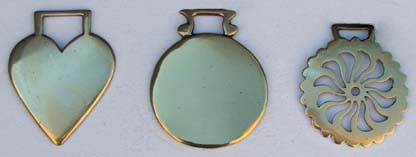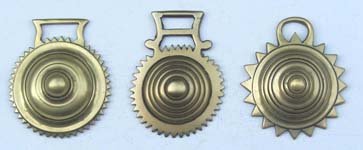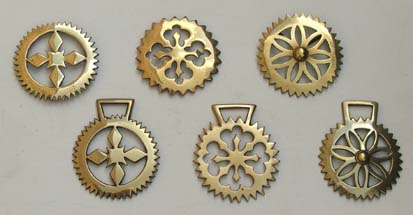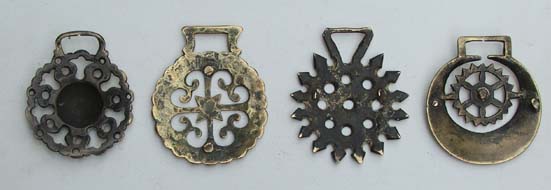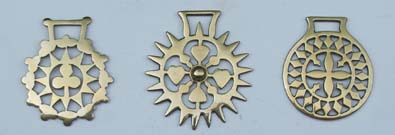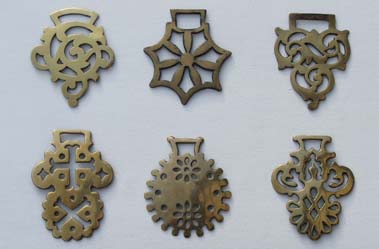Cast Brasses
It is generally agreed that the earliest brass decorations were simple cast studs in a variety of shapes and sizes. The earliest types were probably made by local foundries but by the second half of the 19th Century the production had centred in and around the West Midlands, particularly Walsall.
The casting process used in the manufacture of these brasses was to make a pattern which was pressed into a sand mould, then after removal, molten brass was poured in to the impression to produce a raw casting that could later be worked by hand and finally polished. Anyone who wishes to learn about this process in detail can do so in the Society DVD.
Below, a selection of early studs. These come in a variety of shapes and sizes and may be quite thinly cast. Some may be filled with lead, which was a method whereby most carriage harness decorations were made. Note also the steel fixing pins on the reverse of these, lower row.
Above, three early types developed from stud patterns and below, three smaller types developed from rosettes or bosses. These being early types themselves seem to have hangers added almost as an afterthought.
In the industrial centre of Sheffield, a particular type of studded decoration was so popular that they became known as ‘Sheffield Stars’. These brasses show clearly the early development from stud to hanging brass. By the mid-19th century these simple brasses had caught on and their production became a vast and lucrative industry. In the following decades large quantities of different designs were produced by competing manufacturers.
Below, three Sheffield Stars (top) showing the same patterns with hangers added (beneath). In no other type of heavy horse harness decoration is this transitional stage more apparent.
Most cast brasses display the small stubs on the reverse commonly known as ‘getts’ which, when cast, were an inch or two long. They were needed to ‘get hold’ of the brass in a vice in order to finish it with a file, after which the getts were cut off near the base. Some brasses, even early ones, do not display these projections at all, either by being completely removed in the finishing process or by later harness wear or in some cases using the projection occurring in the casting channel or ‘sprue’ at the top of the hanger, which was then removed in the fettling process.
Below, four brasses photographed from the reverse to show the remains of the positioning of the getts clearly visible except for the first example which has none at all.
The collecting of horse brasses as a popular pastime commenced in the late 19thC, often by women for home decoration. The first serious collectors’ manuals were H S Richards’ three volume ‘Horse Brass Collections’ published in 1944. These were followed over the years by several specialist works by different authors before the National Horse Brass Society began to publish their own expanding series of specialist collectors books (see Bibliography section in Shop).
Below, six rare brasses illustrated in the two-volume NHBS publication ‘The Collectors Anthology of Antique Horse Brasses’


